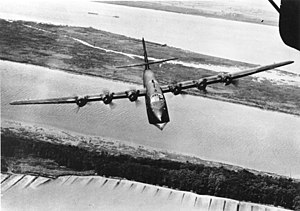Blohm & Voss BV 222
| BV 222 | |
|---|---|
 |
|
| Role | Flying boat |
| Manufacturer | Blohm & Voss |
| First flight | 7 September 1940 |
| Primary user | Luftwaffe |
| Number built | 13 |
The Blohm & Voss BV 222 (German: "Viking") was a large, six-engined German flying boat of World War II. Originally designed as a commercial transport, it was the largest seaplane to attain production status during the war.
Prior to World War II, the German airline Luft Hansa had carried out many transatlantic mail flights. However, their main interest was passenger transport, and they initiated a program in 1936 that culminated in an order for three BV 222 flying boats designed by Dr. Richard Vogt.
Construction of the first prototype, V1, began in January 1938, with construction of the V2 and V3 following within weeks. V1 made its test flight on 7 September 1940, carrying the civil registration D-ANTE. During trials it demonstrated that it could carry up to 92 passengers, or 72 patients on stretchers over short distances at a maximum speed of 385 km/h (239 mph). The flight characteristics were found to be satisfactory, but with some improvements required. Further trials lasted until December 1940, when the V1 passed into Luftwaffe service, receiving a military paint scheme and the Stammkennzeichen registration code of CC+EQ, later changed to the Geschwaderkennung designation of X4+AH, when in service with Lufttransportgruppe (See) 222.
The type was noted for a long flat floor inside the cabin and a large square cargo door aft of the wing on the starboard side, with such a flat floor for the hull interior being a welcome novelty for that era. The usual balance floats for a flying boat design were ingeniously designed as a matching pair of retracting float units per side, which extended from beneath the wing's outer panels in "clamshell" fashion when fully extended, and fit fully flush with the wing panels' undersides when retracted. Only 13 aircraft are thought to have been completed.
Originally powered by Bramo 323 Fafnir radial engines, later aircraft were powered by six 746 kW (1,000 hp) Jumo 207C inline two-stroke opposed-piston diesel engines. The use of diesels permitted refueling at sea by special re-supply U-boats. C-13 aircraft was a sole example fitted with Jumo 205C and later Jumo 205D engines.
...
Wikipedia
